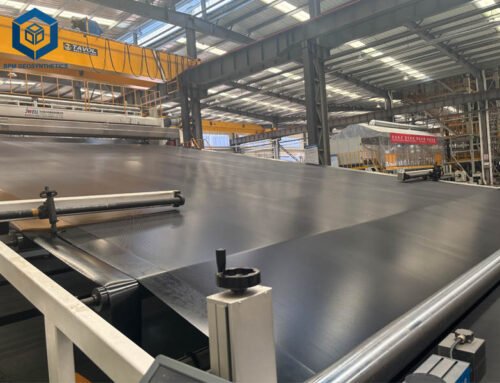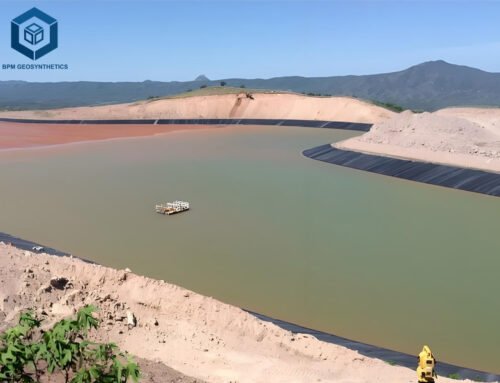Landfill geomembrane is a critical component in modern waste management systems, designed to prevent the leakage of harmful substances into the surrounding environment. As a high-performance synthetic material, it acts as a barrier to contain contaminants within landfills, ensuring the protection of soil and groundwater. Among the leading providers of these essential materials is BPM Geosynthetics, a company renowned for its innovative solutions in the field of geosynthetics. With a commitment to quality and sustainability, BPM Geosynthetics offers a range of geomembrane products tailored to meet the diverse needs of landfill applications, from municipal waste sites to hazardous material containment. This article explores the significance of landfill geomembranes and highlights the role of BPM Geosynthetics in advancing environmental protection through cutting-edge geosynthetic technologies.
1. What Exactly Is Landfill Geomembrane?
Landfill Geomembrane uses plastic film as the anti-seepage base material and is a geotextile anti-seepage material compounded with non-woven fabrics. The anti-seepage performance of the new material Landfill Geomembrane mainly depends on the anti-seepage performance of the plastic film. Landfill Geomembrane are known for their durability, flexibility, and resistance to chemicals and temperature changes, making them ideal for many environments. Landfill Geomembrane play an important role in protecting the environment and human health by preventing soil and groundwater contamination and providing a barrier against harmful vapors.
We’ll explore Landfill Geomembrane, their properties, applications, and their future.
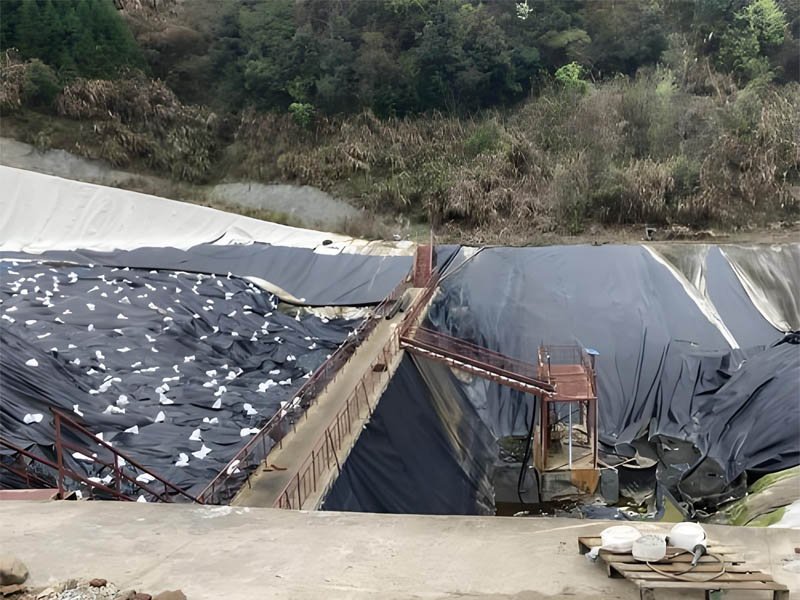
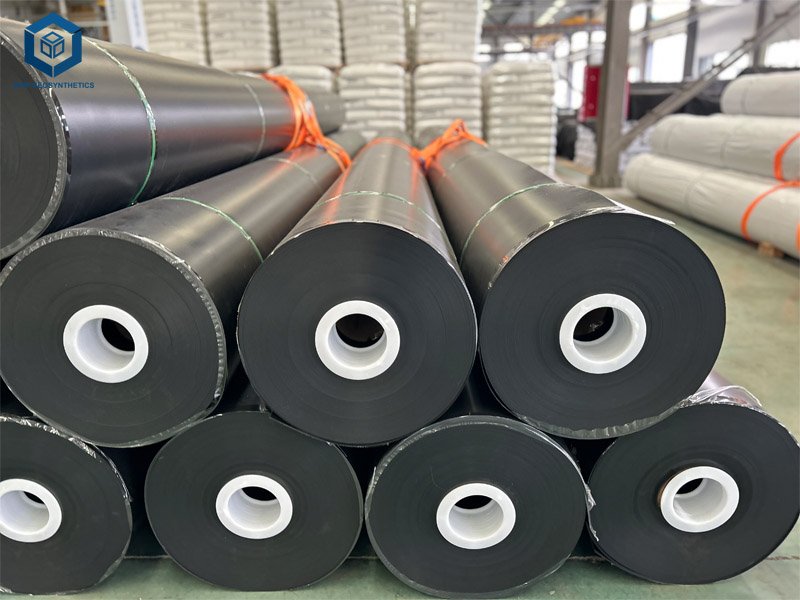
2. What Are The Types Of Landfill Geomembranes?
Several types of Landfill Geomembrane can be used depending on the matrix resin used. The most commonly used Landfill Geomembrane are listed below.
2.1 PVC Landfill Geomembrane
PVC (polyvinyl chloride) Landfill Geomembraneis a thermoplastic waterproofing material made of vinyl, plasticizers and stabilizers.
When dichloroethane cracks into dichlorides, the products polymerize to create the polyvinyl chloride resin used in PVC Landfill Geomembrane.
PVC Landfill Geomembrane are tear, abrasion and puncture resistant and are suitable for use in the construction of canals, landfills, soil remediation, wastewater lagoon liners and storage tank liners.The material is also ideal for maintaining drinking water and preventing contaminants from entering water sources.
2.2 TRP Landfill Geomembrane
TRP (reinforced polyethylene) Landfill Geomembraneuse polyethylene fabrics for long-term waterproofing and industrial waste applications.
TRP Landfill Geomembrane are ideal for soil remediation, landfills, canals, temporary reservoir linings, agricultural and municipal applications due to their low temperature range, chemical resistance and UV stability.
2.3 HDPE Landfill Geomembrane
High-density polyethylene (HDPE) offers strong UV/temperature resistance, low material cost, durability and high chemical resistance.
It is the most commonly used Landfill Geomembrane because it has a higher thickness that other Landfill Geomembrane do not have. HDPE is the first choice for pond and canal lining projects, landfills and reservoir covers.
2.4 LLDPE Landfill Geomembrane
LLDPE (Linear Low Density Polyethylene) Landfill Geomembraneis made of pure polyethylene resin, which is strong, durable, UV and low temperature resistant.Engineers and installers who need an impermeable Landfill Geomembrane often choose LLDPE because of its greater flexibility compared to HDPE.They are used in industrial applications such as animal and environmental waste containers and liquid storage tanks.
2.5 RPP Landfill Geomembrane
RPP (reinforced polypropylene) Landfill Geomembraneare polyester-reinforced liners made from UV-stabilized polypropylene copolymers that provide material stability, chemical resistance, and flexibility.Its strength and durability can be traced back to the nylon scrim support. RPP Landfill Geomembrane are ideal for long-term waterproofing and industrial waste applications.
2.6 EPDM Landfill Geomembrane
EPDM (ethylene propylene diene monomer) Landfill Geomembranehas a rubber-like texture that gives it durability, UV stability, strength, and flexibility.They are ideal for extreme weather conditions and puncture resistant. EPDM Landfill Geomembrane are easy to install and are commonly used as surface barriers in dams, liners, mulches, backyard landscaping and other irrigation sites.
3. What Are The Characteristics Of Landfill Geomembrane?
Landfill geomembranes are engineered with specific characteristics to ensure their effectiveness in waste containment and environmental protection. These synthetic liners are designed to be highly impermeable, durable, and resistant to chemical and environmental degradation. Key characteristics include excellent tensile strength to withstand stress and deformation, high puncture resistance to prevent damage from sharp objects, and UV resistance to maintain integrity under prolonged sun exposure. Additionally, landfill geomembranes exhibit chemical resistance, ensuring they can handle exposure to leachates and other hazardous substances commonly found in landfills.
BPM Geosynthetics, a leading manufacturer in the geosynthetics industry, produces high-quality landfill geomembranes that meet international standards. Their products are known for their consistent thickness, flexibility, and longevity, making them ideal for demanding landfill applications. BPM Geosynthetics also emphasizes sustainability, offering geomembranes that contribute to effective waste management and environmental conservation.
4. What Other Projects Can Landfill Geomembrane Be Applied To?
Landfill geomembranes are not limited to waste containment; their exceptional properties make them highly suitable for a variety of industrial projects. These synthetic liners are designed to provide impermeability, chemical resistance, and durability, making them ideal for applications where environmental protection and containment are critical. Below are some key industrial projects where landfill geomembranes are widely used.
4.1 Mining Operations
In the mining industry, geomembranes are essential for lining tailings ponds and heap leach pads. They prevent the leakage of toxic chemicals, heavy metals, and acidic solutions into the surrounding soil and groundwater. This ensures compliance with environmental regulations and minimizes the ecological impact of mining activities.
4.2 Oil and Gas Industry
Landfill geomembranes are used in the oil and gas sector for secondary containment areas, such as around storage tanks and pipelines. They provide a reliable barrier against spills and leaks, preventing hazardous substances from contaminating the environment.
4.3 Industrial Wastewater Treatment
In wastewater treatment plants, geomembranes line treatment ponds, lagoons, and tanks to prevent the seepage of harmful effluents into the ground. This is particularly important in industries that produce large volumes of contaminated water, such as chemical manufacturing and food processing.
4.4 Chemical Storage Facilities
Geomembranes are used to create secure containment areas for hazardous materials in chemical storage facilities. They act as a protective barrier, ensuring that any accidental spills or leaks do not reach the surrounding environment.
4.5 Power Generation Projects
In the power generation sector, geomembranes are used in coal ash containment systems to prevent the leaching of ash residues into groundwater. They are also applied in solar farms and hydropower projects for lining reservoirs and evaporation ponds.
4.6 Industrial Landfills and Hazardous Waste Sites
Beyond municipal landfills, geomembranes are used in industrial landfills and hazardous waste sites to safely contain toxic materials. They provide a robust barrier that prevents contaminants from spreading into the environment.
BPM Geosynthetics: Delivering Solutions for Industrial Applications
BPM Geosynthetics is a leading manufacturer of high-quality geomembranes, offering products that meet the demanding requirements of industrial projects. Their geomembranes are known for their strength, flexibility, and chemical resistance, making them suitable for a wide range of applications. With a focus on innovation and sustainability, BPM Geosynthetics provides tailored solutions that help industries achieve their environmental and operational goals.
By leveraging advanced manufacturing techniques and rigorous quality control, BPM Geosynthetics ensures that their geomembranes deliver reliable performance in even the most challenging industrial environments. Whether it’s mining, oil and gas, or wastewater treatment, their products play a crucial role in protecting the environment while supporting industrial progress.
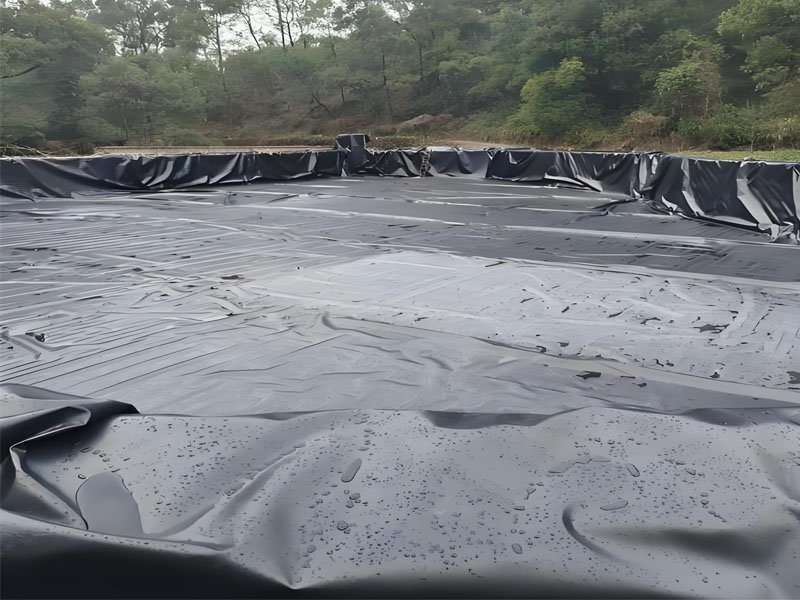
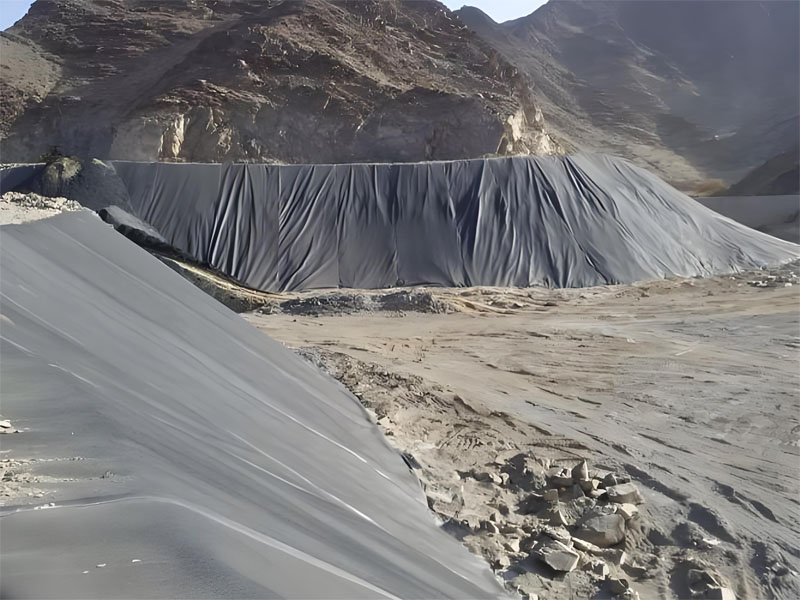
5. How to Construct Landfill Geomembrane?
Constructing a landfill geomembrane is a critical process in waste management projects, ensuring the safe containment of waste and the protection of the surrounding environment. The installation of a geomembrane liner in a landfill project requires careful planning, precise execution, and strict adherence to engineering standards. Below is a step-by-step guide to constructing a landfill geomembrane, using a landfill project as an example.
5.1 Site Preparation
Before installing the geomembrane, the landfill site must be properly prepared to ensure a stable and even base. This involves:
- Clearing the site of vegetation, rocks, and debris.
- Compacting the subgrade to create a smooth and stable surface.
- Installing a protective layer, such as a geotextile or clay layer, to prevent punctures and provide additional support.
5.2 Geomembrane Material Selection
Choosing the right geomembrane material is crucial for the success of the project. Common materials include HDPE (High-Density Polyethylene), LLDPE (Linear Low-Density Polyethylene), and PVC (Polyvinyl Chloride). HDPE is often preferred for landfill applications due to its high strength, chemical resistance, and durability.
BPM Geosynthetics, a leading manufacturer, offers high-quality HDPE geomembranes specifically designed for landfill projects. Their products meet international standards and are engineered to withstand harsh environmental conditions.
5.3 Geomembrane Panel Layout
The geomembrane is typically delivered in large rolls, which are then unrolled and laid out across the prepared site. Key steps include:
- Unrolling the geomembrane panels carefully to avoid wrinkles or folds.
- Overlapping adjacent panels to ensure proper seam formation.
- Anchoring the edges of the geomembrane to prevent movement during installation.
5.4 Seaming and Welding
Seaming is one of the most critical steps in geomembrane installation, as it ensures the liner is watertight and durable. There are two primary methods for seaming:
- Thermal Welding: Using heat to fuse the overlapping panels together.
- Chemical Welding: Applying a solvent to bond the panels.
For landfill projects, thermal welding is commonly used due to its strength and reliability. The seams are tested using air pressure tests or vacuum tests to ensure they are leak-free.
5.5 Quality Control and Testing
Quality control is essential to ensure the geomembrane performs as intended. This involves:
- Inspecting the seams for uniformity and strength.
- Conducting leak detection tests to identify and repair any defects.
- Verifying the thickness and material quality of the geomembrane.
BPM Geosynthetics provides technical support and quality assurance throughout the installation process, ensuring their geomembranes meet the highest standards.
5.6 Covering and Protection
Once the geomembrane is installed, it is often covered with a protective layer, such as:
- Geotextiles to prevent punctures from sharp objects.
- Drainage layers to manage leachate collection.
- Soil or gravel to provide additional protection and stability.
5.7 Final Inspection and Maintenance
After installation, a final inspection is conducted to ensure the geomembrane is properly installed and functioning as intended. Regular maintenance is also required to address any potential issues, such as:
- Monitoring for leaks or damage.
- Repairing punctures or tears promptly.
- Ensuring proper drainage of leachate.
Role of BPM Geosynthetics in Landfill Geomembrane Construction
BPM Geosynthetics plays a vital role in landfill projects by providing high-quality geomembranes and technical expertise. Their products are designed to meet the specific needs of landfill applications, offering excellent chemical resistance, UV stability, and long-term durability. By partnering with BPM Geosynthetics, landfill projects can achieve reliable and sustainable waste containment solutions.
Constructing a landfill geomembrane is a complex but essential process that requires precision, expertise, and high-quality materials. With proper installation and maintenance, geomembranes can effectively protect the environment and ensure the safe containment of waste for decades.
6. Summary
Landfill geomembrane is a specialized synthetic liner used primarily in waste containment systems to prevent the leakage of harmful substances into the environment. Made from materials like HDPE, LLDPE, or PVC, it offers exceptional impermeability, chemical resistance, and durability, making it ideal for applications such as municipal landfills, hazardous waste sites, mining tailings ponds, and industrial wastewater treatment facilities. BPM Geosynthetics, a leading manufacturer in the geosynthetics industry, provides high-quality geomembranes tailored for these applications. Their products are engineered to meet international standards, ensuring reliable performance and long-term environmental protection. By offering innovative solutions, BPM Geosynthetics plays a crucial role in advancing sustainable waste management practices worldwide.

